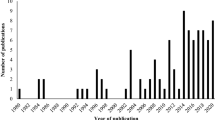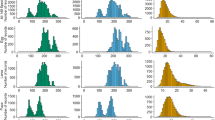Abstract
Light and pheromone trap networks were used to monitor and compare moth catches of Helicoverpa (= Heliothis) armigera (Hubner) in both types of traps at many locations across India. There were obvious changes with latitude in flight patterns and in the correlation between light and pheromone trap catches. At northern locations, the correlation between light and pheromone trap catches were higher as compared to southern locations. The traps located in the central part of India showed correlations, intermediate between those of northern and southern locations. Pheromone traps were thus found suitable for monitoring at northern and central locations. At southern locations, where light and pheromone trap catches differ considerably at different times of the year, both types of traps should be operated simultaneously for better monitoring of this insect. Good correlations were found between larval population and light and pheromone trap catches of H. armigera at Patancheru, one of the southern locations in India.
Résumé
Des réseaux de pièges à phéromones et de piéges lumineux ont été utilisée pour comparer l’activité de vol de Helicoverpa (= Heliothis) armigera (Hubner) dans différentes localités en Inde. L’activité de vol de ce papillon ravageur ainsi que le degré de corrélation entre les résultats des pièges lumineux et des pièges à phéromone varient en fonction de la latitude. Les corrélations entre les résultats des pièges lumineux et des pièges à phéromone sont plus fortes dans le Nord que dans le Sud de l’Inde. Les corrélations observées entre les résultats obtenus par les deux types de pièges pour le Centre de l’Inde ont des valeurs intermédiaires entre celles observées pour le Nord et le Sud du pays. Les pièges à phéromone se sont avérés adéquats pour la surveillance des populations de ce ravageur au Nord et au Centre de l’Inde. Par contre, dans le Sud du pays où les pièges lumineux et les pièges à phéromone donnent des informations très différentes au cours de l’année les deux types de pièges doivent être employés simultanément pour la surveillance efficace de ce papillon ravageur. De bonnes corrélations ont été observées entre les populations larvaires et les prises de H. armigera dans les pièges à phéromone et les pièges lumineux à Patancheru, une des localités du Sud de l’Inde.
Similar content being viewed by others
References
Bhatnagar V. S. and Davies J. C. (1979) Insect light trap studies at ICRISAT Centre. Prog. Rep. Crop. Entomol. 2. ICRISAT, Patancheru, A.P. India.
ICRISAT (International Crops Research Institute for the Semi-Arid Tropics) (1988) Annu. Rep. 1987. Patancheru, A. P. 502 324, India.
Nesbitt B. F., Beevor P.S., Hall D.R. and Lester R. (1980) (Z)-9-Hexadecenal; a minor component of the female sex pheromone of Heliothis armigera (Hubner) (Lepidoptera: Noctuidae). Entomol. Exp. Appl. 27, 306–308.
Pawar C. S., Sithanantham S., Sharma H. C, Taneja S. L., Amin P. W., Leuschner K. and Reed W. (1984) Use and the development of insect traps at ICRISAT. Paper presented at the Nat. Sent, on use of Traps in Vector Res. and Control, 10–11 March 1984 at Bidhan Chandra Krishi Vishwa Vidhyalaya, Kalyani, West Bengal, India.
Pawar C. S. Sithanantham S., Bhatnagar V. S., Srivastava C. P. and Reed W. (1988) The development of sex pheromone trapping of Heliothis armigera at ICRISAT, India. Trop. Pest Manage. 34, 39–43.
Pawar C. S., Srivastava C. P. and Reed W. (1986) Some aspects of population dynamics of Heliothis armigera at ICRISAT Center. In Proc. of III Oriental Entomol. Symp., 21–24 February, 1984, Trivendrum, Kerala, India.pp. 79–85.
Sachan J. N. (1987) Status of the gram pod borer, Heliothis armigera (Hubner) in India and its management. In Recent Advances in Entomology (Edited by Mathur Y. K., Bhattacharya A. K., Pandey N. D., Upadhyaya K. D. and Srivastava J. P.), pp. 91–110. New Gopal Printing Press, Kanpur, India.
Srivastava C. P. and Srivastava R. P. (1989) Comparison of Heliothis armigera (Hubner) male moth catches in light and pheromone traps at Udaipur, Rajas than, India. Insect Sci. Applic. 10, 565–568.
Author information
Authors and Affiliations
Rights and permissions
About this article
Cite this article
Srivastava, C.P., Pimbert, M.P. & Reed, W. Monitoring of Helicoverpa (=Heliothis) Armigera (Hubner) Moths with Light and Pheromone Traps in India. Int J Trop Insect Sci 13, 205–210 (1992). https://doi.org/10.1017/S1742758400014363
Received:
Revised:
Published:
Issue Date:
DOI: https://doi.org/10.1017/S1742758400014363




